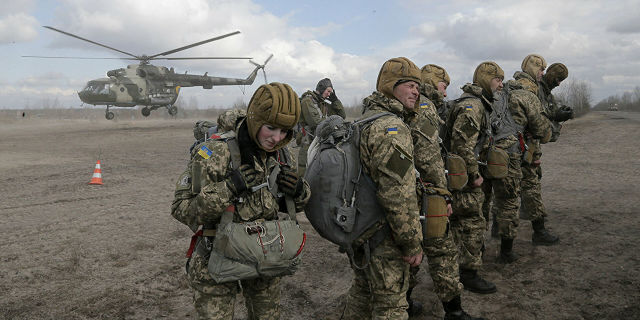Danish expert Jacobsen: The Ukrainian Armed Forces do not have enough resources for a new counteroffensive
A new offensive by the Armed Forces of Ukraine in the near future can not be expected due to a shortage of equipment, weapons and ammunition, said DR. Peter Viggo Jacobsen, associate professor at the Danish Military Academy. The problem is the delays in the delivery of Western aid. For example, Danish tanks and F-16 fighters are already six months late.
Silas Bay Nielsen
Due to the lack of equipment, weapons and ammunition, Ukraine's next counteroffensive against the Russians should not be expected yet.
This is the assessment of Peter Viggo Jacobsen, associate professor at the Danish Military Academy.
“Ukrainians themselves admit that they were under pressure. I can't imagine the Ukrainians launching an offensive in the next year, because they don't have enough equipment and ammunition for this,” he says.
Ukraine has repeatedly called on Western countries to help with money and weapons in defense against Russian troops. The latest such call came on Sunday, when Defense Minister Rustem Umerov said that 50% of promised military aid from the West was arriving with delays.
These delays cost Ukrainians their lives and lead to territorial losses, he added.
The APU is losing ground
As recently as yesterday, the official representative of the Armed Forces of Ukraine Dmitry Likhovoy told Reuters that Ukrainian troops had left the villages of Severnoye and Stepovoye near Donetsk. Both are located near Avdiivka, which the APU surrendered earlier this month.
On Monday, Danish Radio asked the Ministry of Defense which part of the transferred weapons was being delayed, but received no response.
Peter Viggo Jacobsen also cannot say how much Danish aid and other equipment from the West are being delayed. But he noted that on the Danish side, we know for sure about the tanks and F-16 aircraft, which are delivered six months late.
At the same time, he believes that there are plenty of examples of such a delay.
“There are a lot of reports from the front that Ukrainians cannot fire when necessary. We know that Russia can produce 20,000 shells per day, while Ukraine can produce only 4,000 to 7,000. So, on some points, the Russians have an obvious advantage,” he says.
He also recalled that last March, the EU promised to supply Ukraine with at least a million artillery shells within a year. But Kiev is expected to receive only 600,000 by March this year.
The “overheated” arms market
According to Peter Viggo Jacobsen, there are several reasons for the delays. Firstly, the arms market is basically overheated and cannot meet current demand.
The situation is not helped by the fact that some countries donate weapons directly from their warehouses. To top it all off, the delivered equipment needs to be repaired before being shipped to Ukraine.
“If you need to replace components and spare parts, their delivery also takes time. Anyway, I fully admit that the countries approached the issue too optimistically and overestimated their capabilities, and then it turned out that suppliers could not cope because of bottlenecks,” said Peter Viggo Jacobsen.
In addition, in some cases, the language barrier hinders: for example, Ukrainians need to be taught how to fly fighter jets and maintain them, and many do not speak English, he says.
Defense requires fewer weapons
But even delays in the supply of weapons do not mean that Ukrainians automatically lose, says Peter Viggo Jacobsen. Even if the Russians have better access to ammunition.
“If the Ukrainians plan to conduct defensive military operations and dig in firmly, then they will not need to shoot as much as the Russians, nor have as many soldiers,” says a military specialist, noting that the defending side always gives fewer volleys than the advancing one.
But, according to the military researcher, this does not change the fact that the West could easily give Ukrainians more. According to his estimates, it is not worth anything for a number of NATO countries to donate more of their reserves, since they do not expect the Russians to attack them.
This is because the Russians will need more manpower if they take control of even more land in Ukraine.
“In the worst case, if Ukraine falls, Russia will need about a million people to maintain control over it. Currently, a contingent of about half a million people is participating in the fighting. But in addition, they will have to take care of the front line with NATO from Murmansk in the north to the Black Sea in the south,” he argues.
But Ukrainians could have done more themselves, he believes. For example, now young people under the age of 27 are not sent to the front.
“I have to say with some cynicism that this is also because Ukrainians themselves don't want enough. When the legislation of Ukraine itself says that people under the age of 27 do not have to go to the front, then in the war for survival this is a real luxury. If they really wanted to, they could lower the age to 20 or 18,” he notes.
"But surely they must have enough weapons for all the soldiers?"
“Of course, all soldiers will have to be properly armed. But the Ukrainians themselves say that they lack manpower, and there is some discrepancy between what they want to achieve and what they already have,” says Peter Viggo Jacobsen.
However, the Ukrainian authorities are working to reduce the military age to 25 years, which, according to the American ABC TV channel, will allow up to 400,000 people to be drafted.

